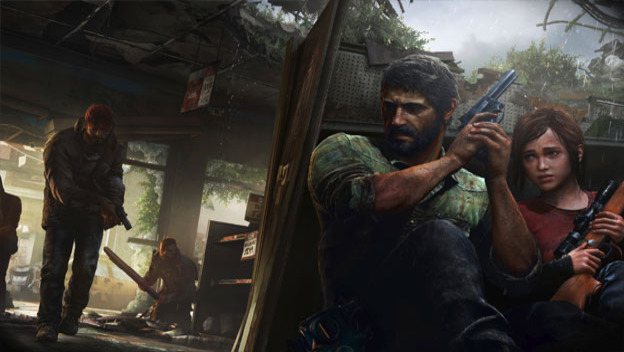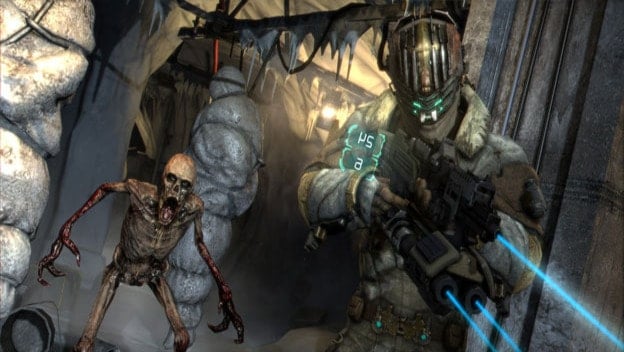There has been much written about the sound elements of the Dead Space series, and it’s all probably well-deserved. I mean, Isaac Clarke’s adventures are packed with weird little audio quirks that can be brilliantly disorienting. But I recently got a chance to play about a half hour of Naughty Dog’s upcoming The Last of Us, and I have to say its sound design is equally as brilliant as Dead Space’s, though the “soundscapes” of those two games are practically polar opposites.
As I mentioned before, Dead Space’s audio cues are often there to disorient the player. Isaac, the game’s protagonist, is struggling with insanity, and the game works very hard to immerse you in his madness. And that can be terrifying.
For example, as you walk down a hallway, you’ll often hear Necromorphs scampering through the vents around you. Sometimes they’ll pop out and attack, while other times they won’t. The idea of knowing something’s there but not being able to see it, not being sure as to whether or not to prepare for a fight, keeps you on edge. Additionally, you’ll hear some really bizarre things—there are constant strange whisperings, and at one point, you’ll hear a little girl singing while you ride an elevator. And that’s creepy as hell. ( Dead Space 3 plays with some similar themes thanks to the new character, John Carver, for any players who attempt to tackle the co-op-only side missions.)
But The Last of Us takes a vastly different approach. The sound effects are designed to keep players aware of their surroundings. In fact, those of us with excellent ears will be able to tell where enemies are located based on sound alone.
I spoke with Jacob Minkoff, the game’s Lead Game Designer, who told me: “Audio in general is a huge part of The Last of Us.”
Now, that’s a painfully vague statement on its own, but Minkoff explained further, telling me about how the game modifies its sounds dynamically on the fly. You see, real-life sound changes as it bounces off things and travels through/around physical objects. The Last of Us attempts to replicate that in the game’s environment. In Minkoff’s words: “We have probably the most complicated portal occlusion system that anyone’s ever built in a video game. When sound is coming from a door around a hallway, we are actually modeling not only the muffling of coming through the walls, but the bouncing down the hallway… It sounds more reverberated the further you are away and when you’re through walls, so you can pick that out.”
Naughty Dog basically wants the audio experience to guide the players, especially in areas where they can’t see very well. Minkoff continued: “Sound also informs the gameplay. You’re in this dark environment, you can barely see, there are enemies all over the place and some of them can kill you in a single hit. So you need to be able to hear those. You need to say, ‘That’s the sound of a Clicker. I recognize the sound of a clicker. Okay. And he’s over to the right, and it sounds like he’s muffled behind a wall.’”
But guiding players isn’t the only reason for the audio design direction; it’s also there to underscore the action that’s going on in the game, following the game’s motif of contrast. “This is a game of contrast. I’ve mentioned this before. It’s about, you know, Joel and Ellie, protector/protected, high tension/low tension, dilapidated decaying world but beauty of nature retaking it. And the same thing goes into the sound. It has to be quiet, it has to be subtle, it has to be ambient and beautiful, so that the moments of violence and loudness stand out that much more. You know, so that a low bass rumble of tension entering into a combat area informs you, ‘Oh no, this is going to get scary here.’”

And that’s not just in reference to the sound effects; it also applies to the game’s music: “And the music has to be minimal, right? It can’t be constantly swelling orchestral score; it has to inform the narrative moments. But just let all the combat play.”
Oh, and speaking of the game’s score, Minkoff told me a neat little story about how that came together: “We [at Naughty Dog] talk a lot about No Country for Old Men. Gustavo Santaolalla was the composer on that, and he’s now the composer on our game because we loved that so much… The sound design in that movie. It was so tense. Everything was so tense… You could cut the tension with a knife. And the music, the sound design, was so integral to that.
“We said, ‘No one has ever done this in a video game. How can we do this?’ So we called him up, and he’s never done a video game before. And we’re like, ‘Here’s the game we want to make. Here are… the mature themes that we want to handle, the characters, the world. Are you interested?’ And he was like, ‘Yes. I am interested.’
“So it’s been this really cool journey where we saw this beautiful piece of art, No Country for Old Men, and we said, ‘That has so much that could be offered to the games industry in general. No one’s ever tried that. Let’s try it.’ And now we have the guy who did the sound design in that helping us out, helping us make that.”
In the half hour I spent actually playing The Last of Us, I definitely heard a lot of these really cool elements that Minkoff talked about, and I’ll say from firsthand experience that the game’s audio design direction is absolutely fantastic. It’s just one more reason to be excited for the June debut of The Last of Us.
 | By Josh Wirtanen Editor / Social Media Date: February 15, 2013 |
